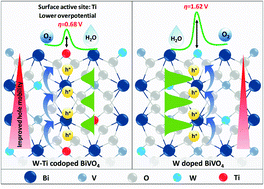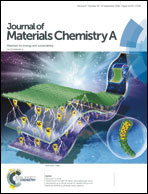Simultaneous enhancement in charge separation and onset potential for water oxidation in a BiVO4 photoanode by W–Ti codoping†
Abstract
Efficient charge separation of photo-generated electrons and holes is critical to achieve high solar to hydrogen conversion efficiency in photoelectrochemical (PEC) water splitting. N-type doping is generally used to improve the conductivity by increasing the majority carrier density and enhance the charge separation in the photoanode. However, minority carrier transport is also very important in the process of charge separation, especially in materials that possess inadequate minority carrier mobility. Herein, we take a BiVO4 PEC water splitting cell as an example to demonstrate how to analyze the limiting factor and to formulate the corresponding solutions to improve the hole mobility. The benefits and problems caused by n-type doping (W-doping here) of BiVO4 are analyzed. Codoping with Ti further enhances the charge separation by improving the hole transport and leads to a cathodic shift of the photocurrent onset potential. A high charge separation efficiency (79% at 1.23 VRHE) in a compact BiVO4 photoanode has been achieved without any nanostructure formation. Theoretical results show that W–Ti codoping has decreased the hole polaron hopping activation energy by 11.5% compared with mono-W doping, and this has resulted in a hole mobility increase by 29%. The calculated adsorption energy and reaction Gibbs free energies indicate that the Ti site is energetically more favorable for water splitting. Moreover, the Ti site possesses a lower overpotential in the W–Ti codoped sample compared with the mono-W doped sample. The current study indicates that in order to improve the solar energy conversion efficiency, there should be a balanced charge transport of both majority and minority charge carriers. This can be achieved by simply choosing appropriate codoping elements.



 Please wait while we load your content...
Please wait while we load your content...